Python - Tokens | 12th Computer Science : Chapter 5 : Core Python : Python Variables and Operators
Chapter: 12th Computer Science : Chapter 5 : Core Python : Python Variables and Operators
Tokens
Tokens
Python breaks each logical line into a sequence
of elementary lexical components known as Tokens.
The normal token types are
1) Identifiers,
2) Keywords,
3) Operators,
4) Delimiters and
5) Literals.
Whitespace separation is necessary between
tokens, identifiers or keywords.
1) Identifiers
An Identifier is a name used to identify a
variable, function, class, module or object.
·
An identifier must start with an alphabet (A..Z or a..z) or
underscore ( _ ).
·
Identifiers may contain digits (0 .. 9)
·
Python identifiers are case sensitive i.e. uppercase and lowercase
letters are distinct.
·
Identifiers must not be a python
keyword.
·
Python does not allow punctuation character such as %,$, @ etc.,
within identifiers.
Example of valid identifiers
Sum, total_marks, regno, num1
Example of invalid identifiers
12Name, name$, total-mark, continue
2. Keywords
Keywords
are special words used by Python interpreter to recognize the structure of program. As these words have specific
meaning for interpreter, they cannot be used for any other purpose.

3. Operators
In computer programming languages operators are
special symbols which represent computations, conditional matching etc. The
value of an operator used is called operands.
Operators are categorized as Arithmetic, Relational, Logical, Assignment etc.
Value and variables when used with operator are known as operands.
(i) Arithmetic operators
An arithmetic operator is a mathematical
operator that takes two operands and performs a calculation on them. They are
used for simple arithmetic. Most computer languages contain a set of such
operators that can be used within equations to perform different types of
sequential calculations.
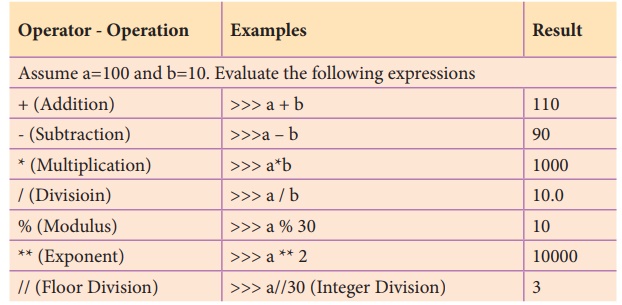
Python supports the following Arithmetic
operators.
Operator - Operation Examples Result
Assume a=100 and b=10. Evaluate the following expressions
+ (Addition) >>>
a + b =110
- (Subtraction) >>>a
– b =90
* (Multiplication) >>> a*b =1000
/ (Divisioin) >>>
a / b =10.0
% (Modulus) >>>
a % 30 =10
** (Exponent) >>>
a ** 2 =10000
// (Floor Division) >>> a//30 (Integer Division) =3
Program 5.1 To test Arithmetic Operators:
#Demo Program to test Arithmetic
Operators
a=100
b=10
print ("The Sum= ",a+b)
print ("The Difference =
",a-b)
print ("The Product=
",a*b)
print ("The Quotient = ",a/b)
print ("The Remainder =
",a%30)
print ("The Exponent = ",a**2)
print ("The Floor Division
=",a//30)
#Program End
Output:
The Sum= 110
The Difference= 90
The Product= 1000
The Quotient= 10.0
The Remainder= 10
The Exponent= 10000
The Floor Division= 3
(ii) Relational or Comparative operators
A Relational operator is also called as Comparative operator which checks the
relationship between two operands. If the relation is true, it returns True; otherwise it returns False.
Python supports following relational operators
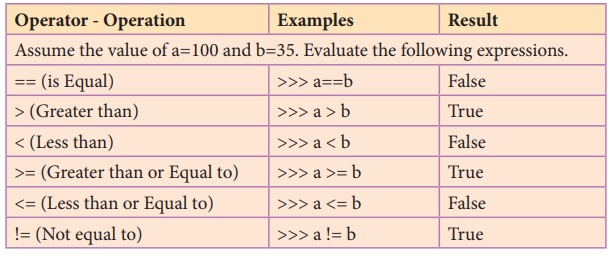
Coding 5.2 To test Relational Operators:
#Demo Program to test Relational
Operators
a=int (input("Enter a Value
for A:"))
b=int (input("Enter a Value
for B:"))
print ("A = ",a,"
and B = ",b)
print ("The a==b =
",a==b)
print ("The a > b =
",a>b)
print ("The a < b =
",a<b)
print ("The a >= b =
",a>=b)
print ("The a <= b =
",a<=0)
print ("The a != b =
",a!=b)
#Program End
Output:
Enter a Value for A:35
Enter a Value for B:56
A = 35 and B= 56
The a==b= False
The a > b= False
The a < b= True
The a >= b= False
The a <= b= False
The a != b= True
(iii) Logical operators
In python, Logical operators are used to
perform logical operations on the given relational expressions. There are three
logical operators they are and, or
and not.
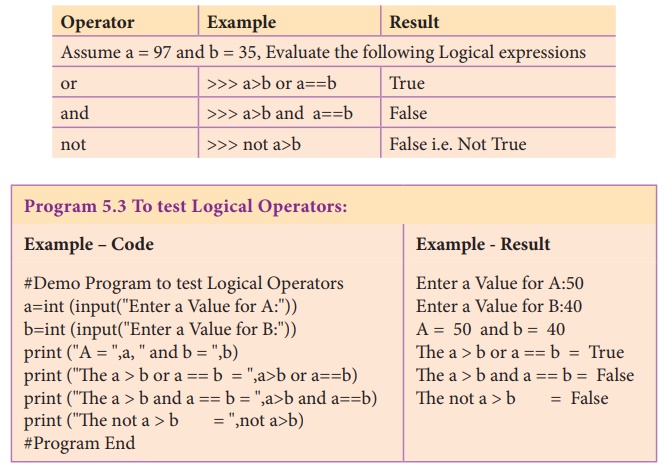
Program 5.3 To test Logical Operators:
Example – Code
#Demo Program to test Logical
Operators
a=int (input("Enter a Value
for A:"))
b=int (input("Enter a Value
for B:"))
print ("A = ",a, "
and b = ",b)
print ("The a > b or a ==
b = ",a>b or a==b)
print ("The a > b and a
== b = ",a>b and a==b)
print ("The not a > b =
",not a>b)
#Program End
Example - Result
Enter a Value for A:50
Enter a Value for B:40
A = 50 and b = 40
The a > b or a == b = True
The a > b and a == b = False
The not a > b = False
(iv) Assignment operators
In Python, = is a simple assignment operator to
assign values to variable. Let a = 5
and b = 10 assigns the value 5 to a and 10 to b these two assignment statement can also be given as a,b=5,10 that assigns the value 5 and 10 on the right to the
variables a and b respectively. There are various compound operators in Python
like +=, -=, *=, /=, %=, **= and //= are also available.
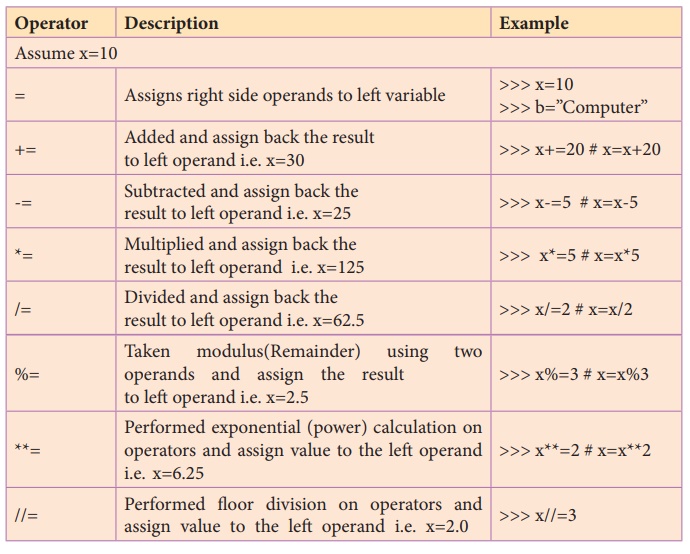
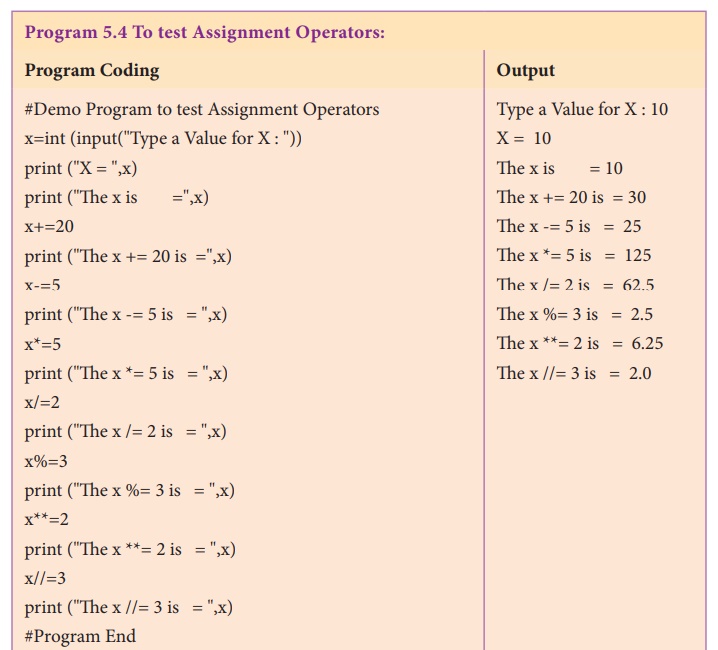
(v) Conditional operator
Ternary operator is also known as conditional
operator that evaluate something based on a condition being true or false. It
simply allows testing a condition in a single line replacing the multiline
if-else making the code compact.
The Syntax conditional operator is,
Variable Name = [on_true] if [Test expression]
else [on_false]
Example :
min= 50 if 49<50 else 70 # min
= 50
min= 50 if 49>50 else 70 # min
= 70
Program 5.5 To test Conditional (Ternary) Operator:
#Program to
demonstrate conditional operator
a, b = 30, 20
#Copy value of
a in min if a < b else copy b
min = a if a < b else b
print ("The Minimum of A and
B is ",min)
# End of the Program
Output:
The Minimum of A and B is 20
4. Delimiters
Python uses the symbols and symbol combinations
as delimiters in expressions, lists, dictionaries and strings. Following are
the delimiters.
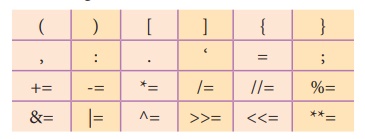
5. Literals
Literal is a raw data given in a variable or
constant. In Python, there are various types of literals.
1. Numeric
2. String
3. Boolean
(i) Numeric Literals
Numeric Literals consists of digits and are
immutable (unchangeable). Numeric literals can belong to 3 different numerical
types Integer, Float and Complex.
Program 5.6 : To demonstrate Numeric literals
# Program to demonstrate Numeric
Literals
a = 0b1010 #Binary Literals
b = 100 #Decimal Literal
c = 0o310 #Octal Literal
d = 0x12c #Hexadecimal Literal
print ("Integer Literals
:",a,b,c,d)
#Float Literal
float_1 = 10.5
float_2 = 1.5e2
print ("Float Literals
:",float_1,float_2)
#Complex Literal
x = 1 + 3.14 j
print ("Complex Literals
:", x)
Print ("x = ", x ,
"Imaginary part of x = ", x.imag, "Real part of x = ",
x.real)
#End of the Program
Output:
Integer Literals : 10 100 200 300
Float Literals : 10.5 150.0
Complex Literals :
x = (1.3.14) Imaginary part of x
= 3.14 Real part of 9 x = 1.0
(ii) String Literals
In Python a string literal is a sequence of
characters surrounded by quotes. Python supports single, double and triple
quotes for a string. A character literal is a single character surrounded by
single or double quotes. The value with triple-quote "' '" is used to
give multi-line string literal.
Program 5.7 To test String Literals
#Demo Program to test String
Literals
strings = "This is
Python"
char = "C"
multiline_str = "'This is a
multiline string with more than one line code."'
print (strings)
print (char)
print (multiline_str)
#End of the Program
Output:
This is Python
C
This is a multiline string with
more than one line code.
(iii) Boolean Literals
A Boolean literal can have any of the two
values: True or False.
Program 5.8 To test Boolean Literals:
#Demo Program to test String
Literals
boolean_1 = True
boolean_2 = False
print ("Demo Program for
Boolean Literals")
print ("Boolean Value1
:",boolean_1)
print ("Boolean Value2
:",boolean_2)
#End of the Program
Output:
Demo Program for Boolean Literals
Boolean Value1 : True
Boolean Value2 : False
(iv) Escape Sequences
In Python strings, the backslash "\" is a special character,
also called the "escape"
character. It is used in representing certain whitespace characters: "\t" is a tab, "\n" is a newline, and "\r" is a carriage return.
For example to print the message "It's raining", the Python command
is
>>>print ("It\'Sn
rainning")
It's ranning
Python supports the following escape sequence
characters.
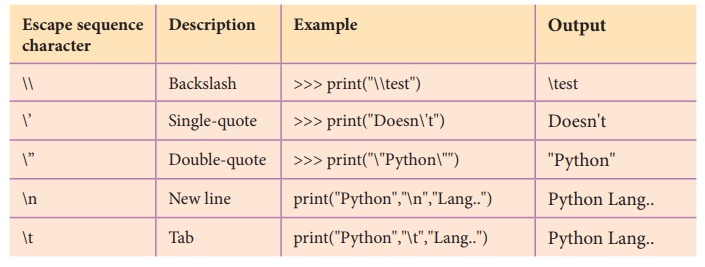
Related Topics